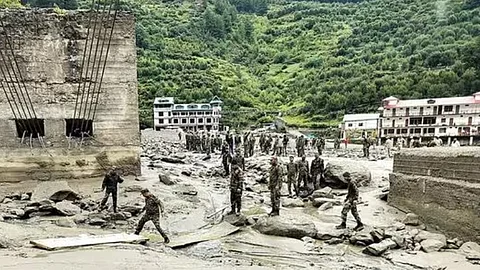

Rescue teams in Uttarkashi continued to dig through thick mud and debris on Wednesday, searching for bodies and possible survivors after flash floods wreaked havoc across multiple villages in the upper Himalayas. The disaster, which struck on Tuesday, destroyed buildings, swept away residents, and cut off critical access routes.
By Wednesday evening, two bodies had been recovered, and officials warned that the death toll is likely to rise. At least 190 people, including 11 Army personnel, were rescued in Dharali village alone, according to SDRF commandant Arpan Yaduvanshi. The injured personnel were airlifted to Dehradun for medical treatment.
Though initial reports pointed to cloudbursts as the cause, experts from the National Disaster Management Authority (NDMA) suspect a glacier collapse upstream of the Kheer Ganga channel may have triggered the deadly deluge. “There are indications that a glacial snout at 6,700 meters detached recently, accumulating debris which was then washed down by incessant rain,” said Safi Ahsan Rizvi, NDMA Advisor and Executive Director of the National Institute of Disaster Management.
Eyewitnesses described scenes of utter devastation. Rakesh Panwar, a resident of Uttarkashi, recounted the last call from his brother Sushil: “Nothing is left… my family couldn’t escape.” His brother, sister-in-law, and young nephew are among the missing.
Dramatic visuals from the site show homes buried under sludge, with fragments of vehicles, buildings, and utility lines protruding from the mud. The Kheer Ganga and Bhagirathi rivers continue to surge dangerously, compounding the threat.
The India Meteorological Department (IMD) has forecast continued heavy rainfall in Uttarakhand for the next 24 hours, with lighter showers expected to persist across the western Himalayas over the coming week.
Several villages including Dharali, Harsil, and Sukki remain the worst hit. Connectivity remains a challenge as a key 100-meter stretch of road near Bhatwari has collapsed, and a crucial bridge at Limchagad has been washed away. Over 100 labourers and six BRO officials are working round-the-clock to restore access. Temporary footbridges and rope crossings have been set up to deliver relief materials, including food and medicines, to stranded residents.
Personnel from the Indian Army, Indo-Tibetan Border Police (ITBP), State Disaster Response Force (SDRF), and Border Roads Organisation (BRO) have been deployed in large numbers. Relief efforts include airdropping essential supplies into inaccessible zones.
Uttarakhand Chief Minister Pushkar Singh Dhami visited Dharali to assess the damage and reassure locals. “The state government is committed to supporting every affected person and restoring normalcy as quickly as possible,” he stated. Senior officials have been placed on continuous emergency duty, monitoring operations from Dehradun’s State Emergency Operations Centre.
Earlier, Prime Minister Narendra Modi spoke with CM Dhami and was briefed on ongoing rescue and relief operations.
This week’s calamity echoes the 2021 Glacier Lake Outburst Flood (GLOF) in Chamoli district that killed over 200 people and devastated the Tapovan Vishnugad Hydropower project. Experts warn that increasing instances of glacier bursts and extreme weather are a stark reminder of the fragility of the Himalayan ecosystem.
Authorities continue to work under challenging conditions, braving dangerous terrain and weather, as hopes of finding more survivors diminish.
(This story is published from a syndicated feed)